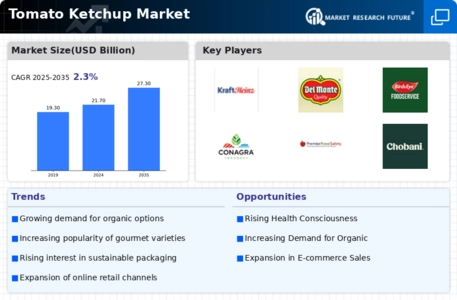Expansion of Food Service Sector
The Tomato Ketchup Market is significantly influenced by the expansion of the food service sector, which includes restaurants, cafes, and fast-food chains. As dining out becomes a more common practice, the demand for condiments like tomato ketchup is expected to rise. Recent statistics suggest that the food service industry is anticipated to grow by around 5% annually, creating a robust market for tomato ketchup as a staple condiment. This growth is further fueled by the increasing popularity of international cuisines that often incorporate tomato-based sauces. Consequently, the Tomato Ketchup Market stands to benefit from this expansion, as food service establishments frequently utilize ketchup in various dishes, enhancing its visibility and consumption.
Innovations in Product Offerings
The Tomato Ketchup Market is witnessing a wave of innovations in product offerings, catering to diverse consumer preferences. Manufacturers are increasingly introducing organic, low-sugar, and gourmet variants of tomato ketchup to meet the evolving tastes of health-conscious consumers. Data indicates that the organic ketchup segment is growing at a rate of approximately 6% per year, reflecting a shift towards healthier eating habits. Additionally, the introduction of unique flavors and blends, such as spicy or herb-infused ketchups, is likely to attract a broader audience. This trend not only enhances consumer choice but also positions the Tomato Ketchup Market as a dynamic sector that adapts to changing culinary trends.
Increased Focus on Sustainability
The Tomato Ketchup Market is increasingly aligning with sustainability initiatives, as consumers become more environmentally conscious. There is a growing demand for products that utilize sustainable sourcing and eco-friendly packaging. Recent surveys indicate that nearly 70% of consumers are willing to pay a premium for sustainably produced goods. This shift is prompting manufacturers to adopt practices that minimize environmental impact, such as using recyclable materials for packaging and sourcing tomatoes from sustainable farms. As sustainability becomes a key purchasing criterion, the Tomato Ketchup Market is likely to see enhanced brand loyalty and consumer engagement, ultimately driving sales.
Growing Popularity of Home Cooking
The Tomato Ketchup Market is benefiting from the growing popularity of home cooking, as more consumers experiment with culinary skills. This trend has been amplified by the increasing availability of recipes that incorporate tomato ketchup as a key ingredient. Data suggests that home cooking has seen a resurgence, with a significant percentage of households preparing meals from scratch. This shift not only increases the demand for tomato ketchup as a staple condiment but also encourages consumers to explore its versatility in various dishes. As home cooking continues to gain traction, the Tomato Ketchup Market is poised for growth, with potential for increased product usage in households.
Rising Demand for Convenience Foods
The Tomato Ketchup Market is experiencing a notable surge in demand for convenience foods, driven by changing consumer lifestyles. As more individuals seek quick meal solutions, the use of tomato ketchup as a versatile condiment has become increasingly popular. According to recent data, the convenience food sector is projected to grow at a compound annual growth rate of approximately 4.5% over the next five years. This trend indicates that tomato ketchup, often paired with fast foods and ready-to-eat meals, is likely to see a corresponding increase in consumption. The convenience factor not only appeals to busy consumers but also aligns with the growing trend of on-the-go eating, thereby enhancing the market potential for tomato ketchup products.

















Leave a Comment